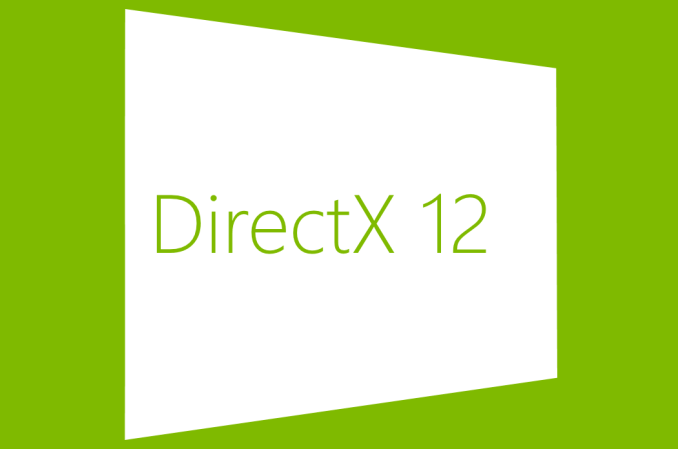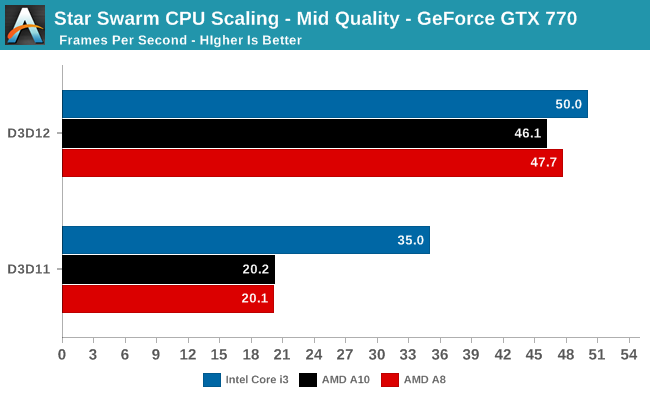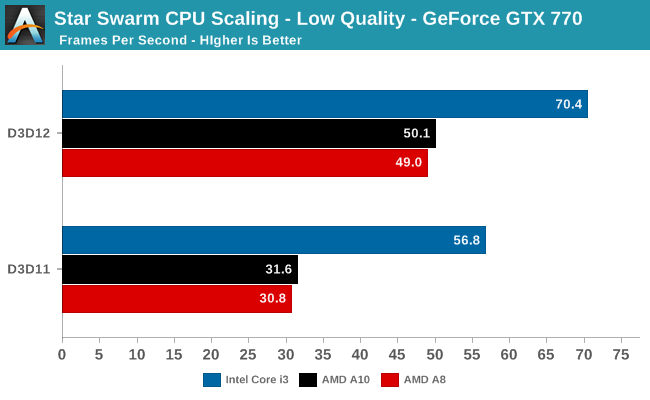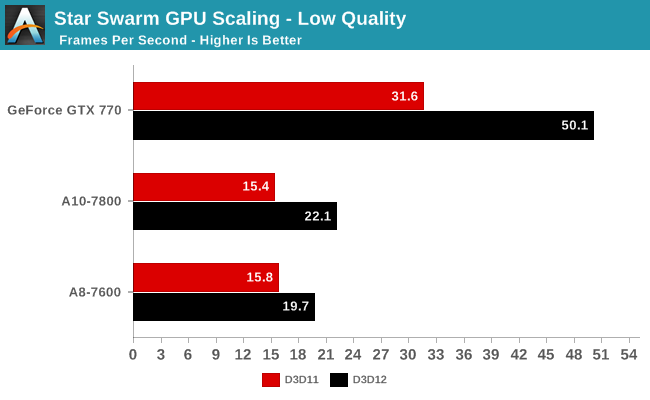Star Swarm, DirectX 12 AMD APU Performance Preview
by Ryan Smith & Ian Cutress on February 13, 2015 10:00 AM EST- Posted in
- GPUs
- AMD
- Microsoft
- APUs
- DirectX 12

After several requests and a week’s break from our initial DirectX 12 article, we’re back again with an investigation into Star Swarm DirectX 12 performance scaling on AMD APUs. As our initial article was run on various Intel CPU configurations, this time we’re going to take a look at how performance scales on AMD’s Kaveri APUs, including whether DX12 is much help for the iGPU, and if it can help equalize the single-threaded performance gap been Kaveri and Intel’s Core i3 family.
To keep things simple, this time we’re running everything on either the iGPU or a GeForce GTX 770. Last week we saw how quickly the GPU becomes the bottleneck under Star Swarm when using the DirectX 12 rendering path, and how difficult it is to shift that back to the CPU. And as a reminder, this is an early driver on an early OS running an early DirectX 12 application, so everything here is subject to change.
| CPU: | AMD A10-7800 AMD A8-7600 Intel i3-4330 |
| Motherboard: | GIGABYTE F2A88X-UP4 for AMD ASUS Maximus VII Impact for Intel |
| Power Supply: | Rosewill Silent Night 500W Platinum |
| Hard Disk: | OCZ Vertex 3 256GB OS SSD |
| Memory: | G.Skill 2x4GB DDR3-2133 9-11-10 for AMD G.Skill 2x4GB DDR3-1866 9-10-9 at 1600 for Intel |
| Video Cards: | MSI GTX 770 Lightning AMD APU iGPU |
| Video Drivers: | NVIDIA Release 349.56 Beta AMD Catalyst 15.200 Beta |
| OS: | Windows 10 Technical Preview 2 (Build 9926) |



To get right down to business then, are AMD’s APUs able to shift the performance bottleneck on to the GPU under DirectX 12? The short answer is yes. Highlighting just how bad the single-threaded performance disparity between Intel and AMD can be under DirectX 11, what is a clear 50%+ lead for the Core i3 with Extreme and Mid qualities becomes a dead heat as all 3 CPUs are able to keep the GPU fully fed. DirectX 12 provides just the kick that the AMD APU setups need to overcome DirectX 11’s CPU submission bottleneck and push it on to the GPU. Consequently at Extreme quality we see a 64% performance increase for the Core i3, but a 170%+ performance increase for the AMD APUs.
The one exception to this is Low quality mode, where the Core i3 retains its lead. Though initially unexpected, examining the batch count differences between Low and Mid qualities gives us a solid explanation as to what’s going on: low pushes relatively few batches. With Extreme quality pushing average batch counts of 90K and Mid pushing 55K, average batch counts under Low are only 20K. With this relatively low batch count the benefits of DirectX 12 are still present but diminished, leading to the CPU no longer choking on batch submission and the bottleneck shifting elsewhere (likely the simulation itself).

Meanwhile batch submission times are consistent between all 3 CPUs, with everyone dropping down from 30ms+ to around 6ms. The fact that AMD no longer lags Intel in batch submission times at this point is very important for AMD, as it means they’re not struggling with individual thread performance nearly as much under DirectX 12 as they were DirectX 11.


Finally, taking a look at how performance scales with our GPUs, the results are unsurprising but none the less positive for AMD. Aside from the GTX 770 – which has the most GPU headroom to spare in the first place – both AMD APUs still see significant performance gains from DirectX 12 despite running into a very quick GPU bottleneck. This simple API switch is still enough to get another 44% out of the A10-7800 and 25% out of the A8-7600. So although DirectX 12 is not going to bring the same kind of massive performance improvements to iGPUs that we’ve seen with dGPUs, in extreme cases such as this it still can be highly beneficial. And this still comes without some of the potential fringe benefits of the API, such as shifting the TDP balance from CPU to GPU in TDP-constrained mobile devices.
Looking at the overall picture, just as with our initial article it’s important not to read too much into these results right now. Star Swarm is first and foremost a best case scenario and demonstration for the batch submission benefits of DirectX 12. And though games will still benefit from DirectX 12, they are unlikely to benefit quite as greatly as they do here, thanks in part to the much greater share of non-rendering tasks a CPU would be burdened with in a real game (simulation, AI, audio, etc.).
But with that in mind, our results from bottlenecking AMD’s APUs point to a clear conclusion. Thanks to DirectX 12’s greatly improved threading capabilities, the new API can greatly close the gap between Intel and AMD CPUs. At least so long as you’re bottlenecking at batch submission.










152 Comments
View All Comments
eanazag - Friday, February 13, 2015 - link
I'm guessing that the Core i3 is simulated from a i5 or i7 since it doesn't list a processor specifically.ddriver - Friday, February 13, 2015 - link
Wow, is this a new low (or high) in pathetic? Reducing CPU overhead finally helps AMD be nearly as fast as an i3 graphics wise?ShieTar - Friday, February 13, 2015 - link
Yeah, the 90€, 4-Thread-APU from AMD is now as fast in this benchmark as the 120€, 4-Thread-APU from Intel. Which definition of pathetic are you using exactly?Now that the software has caught up, the AMD design shows similar performance with the same number of threads, a slightly higher (turbo) frequency and a slightly lower count of transistors.
As far as comparing designs goes, that doesn't sound like a loss for AMD at all. If they had access to a 22nm processing node, we would be right back to a head-to-head competition between the two companies.
ddriver - Friday, February 13, 2015 - link
I sympathize with AMD for being the underdog and loathe the means Intel used to cripple it into a perpetual runner up, but CPU performance for AMD is way too abysmal. They should really focus more on CPU design and less on trying to downplay the importance of raw CPU perf.Price is not a factor, AMD are pushed into having to offer chips at low prices, because their performance is raw, so they have no other way to offer "bang for the buck" than settle for "barely keep afloat" margins.
Fact is, in most workloads, AMD's "utmost high end" is completely annihilated by Intel's midrange, which is my definition of "pathetic" - when your best is beaten by another's "meh".
AMD's problem is trying to beat Intel at their own game - x86. Sure, there are the "Athlon" days, but that happened only because Intel got sloppy enough to bet on the wrong horse. Athlon shined only because P4 sucked lama ballz. I am astounded that so far AMD has not come up with their own ISA, after all, this is the 21 century, "Intel compatible" is no longer a requirement for commercialism, just look at ARM. AMD totally has the resources to provision for their own ISA software wise, and their own ISA could easily diminish the handicap of having to conform to Intel without having the manufacturing edge. But I guess for AMD it suffices to be a "pseudo competitor" to Intel, just so that people don't get to point at the latter and cry "monopoly".
Oh, and not forget that awesum fella HECKtor RuiNz, who stepped just in time to ruin the rarity "successful AMD", an act made that much more amusing by all the ANALysts, praising him for the ridicuous price he paid for ATi, just to have AMD+ATi be worth half of what they paid for the latter in just a couple of years. It's like there is an industry plot against AMD, now fabless and settling for even lower margins, which is somehow also pimped as a "good thing".
dgingeri - Friday, February 13, 2015 - link
Actually, AMD is working on a new x86 core. (http://www.anandtech.com/show/7991/amd-is-also-wor... It just takes quite a while to get that out the door. I'm sincerely hoping it bring some competition to Intel, sometime soon. As it is, Intel is stuck in neutral while we continue to pay for new chips with barely any advantage in performance.ddriver - Friday, February 13, 2015 - link
Yes, Intel is in sleep mode again, but hey, I kind of like that. Haven't felt the need to upgrade my farm since 4770. If you buy new, it doesn't really matter, since product tears come at the same price, if you already have a recent system, no need to upgrade.The downside is that due to lack of competition, Intel started investing in the waste of silicon real estate in the form of iGPUs barely any prosumer takes advantage of, and would really prefer 2 extra cores. In other words, the lack of competition helps Intel bundle uselessness and gain GPU market share. And the privilege of pushing products which do not waste die area on iGPU at a hefty price premium. High margins - gotta lovem.
inighthawki - Friday, February 13, 2015 - link
Those integrated chips are used on a massive scale, especially in ultrabooks and hybrid devices. It also drives down the cost of desktops that no longer need dedicated video cards. For those who are gamers/enthusiasts or plan to buy a dedicated card, Intel ships the -E series of CPUs that do literally exactly what you ask, and replace the integrated GPU with two/four extra CPU cores.ddriver - Friday, February 13, 2015 - link
I am talking about i7, integrated graphics in entry level and midrange makes sense.inighthawki - Friday, February 13, 2015 - link
I'm not seeing your point. If you're talking about i7, then that's exactly what they offer, and exactly what I stated. Go buy a Haswell-E i7 for only slightly more and get extra cores and no GPU. I'm not sure what your complaint is - that ALL i7's don't come without a GPU? Why would you request such a thing when it's already an optional feature? There are actually people who want high end processors with integrated graphics.anandreader106 - Friday, February 13, 2015 - link
@inighthawki I absolutely agree with you. It's not even up for debate in the corporate world. I work for a very large employer and we all get laptops with i7 processors but have no need for anything beyond the integrated GPU solution.